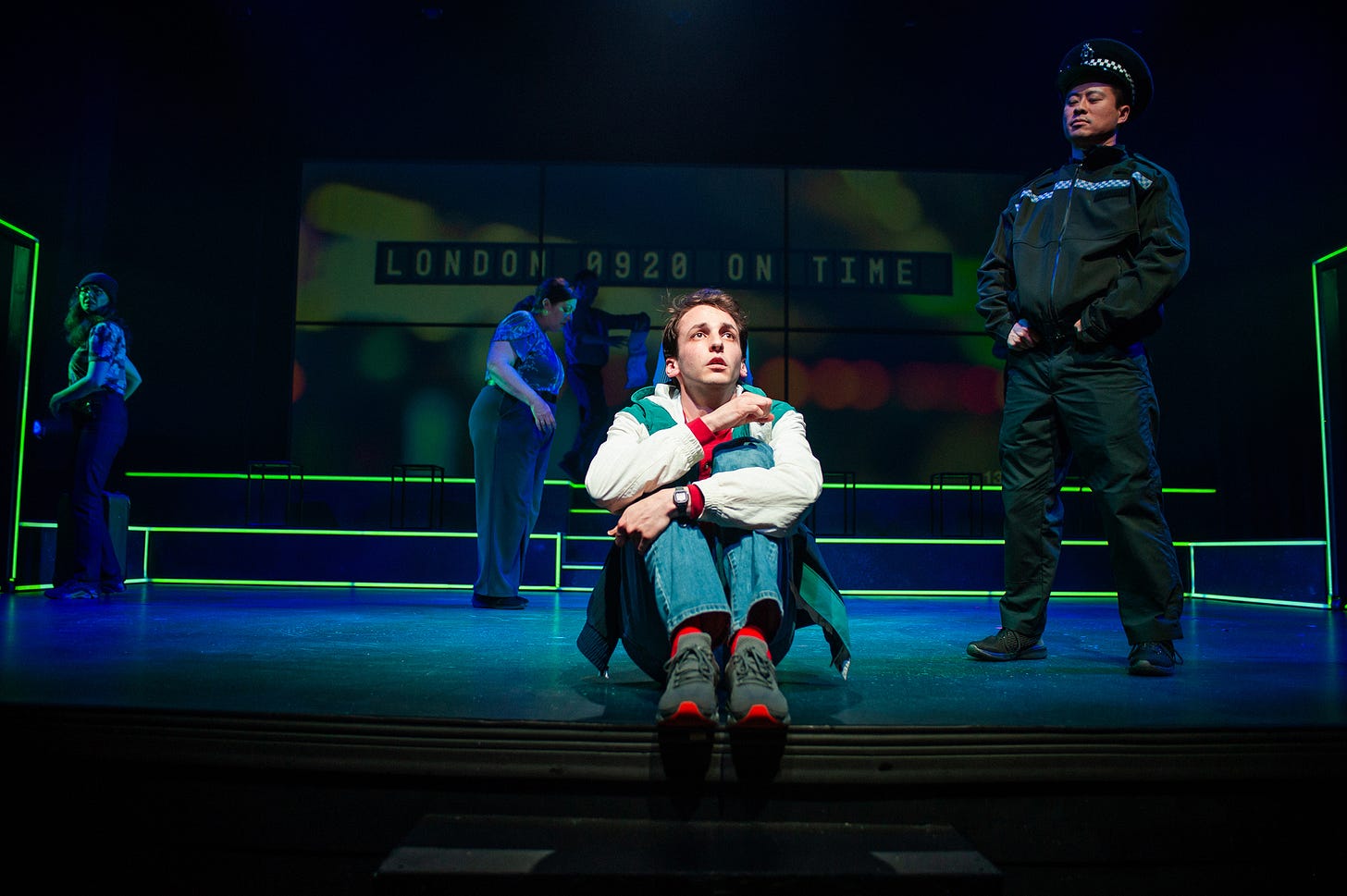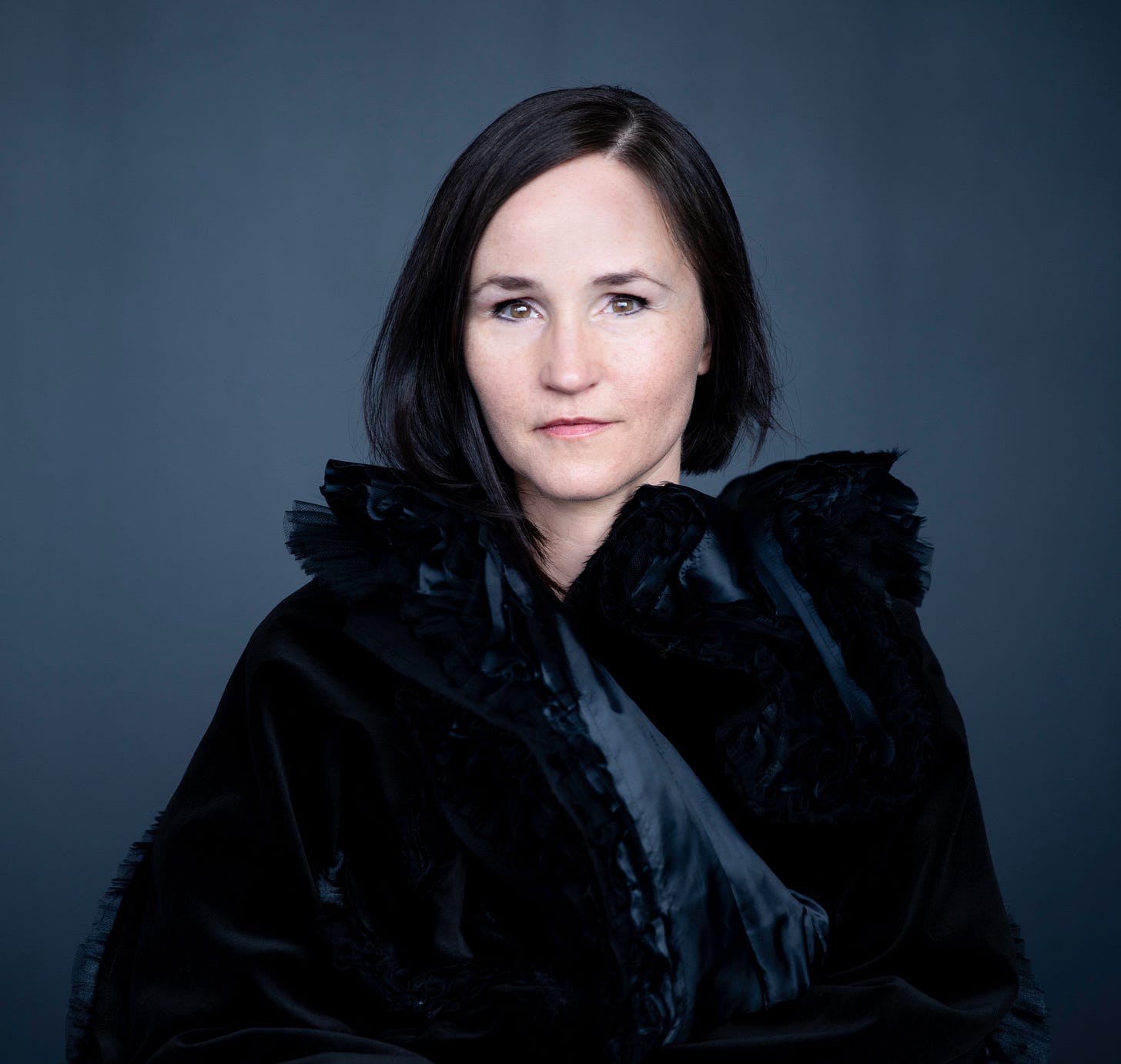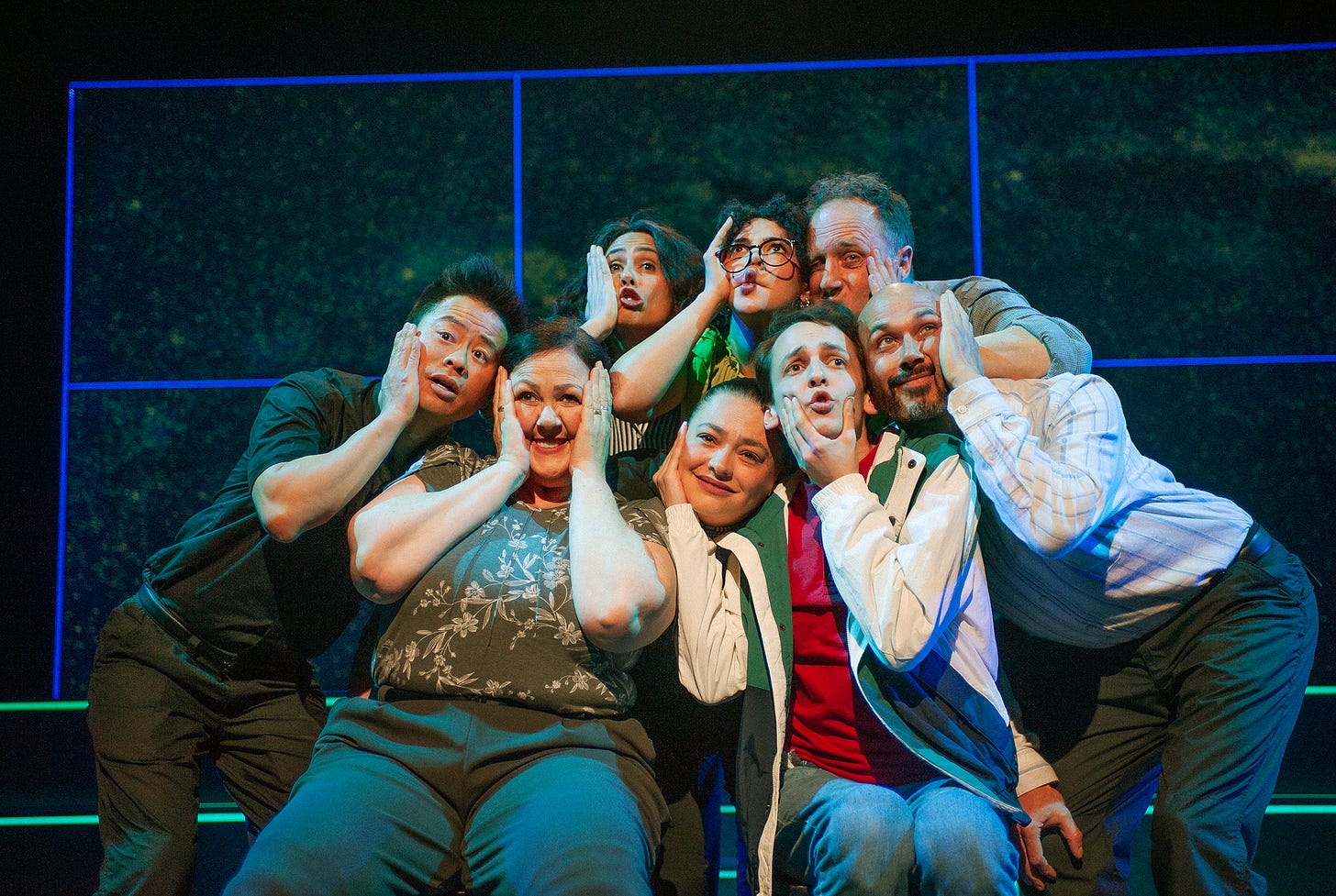Wondrous wandering
Anna Thorvaldsdottir's new cello concerto set the soloist on an arduous trek

The traditional 19th-century view of the concerto, at least to a first approximation, pits the soloist against the orchestra in a battle of wills. Later generations, though, ginned up plenty of variations — or even subversions — of this basic template.
In Before we fall, the imposing new cello concerto by the Icelandic composer Anna Thorvaldsdottir that had its commissioned world premiere in San Francisco on Thursday, May 15, the soloist becomes a wanderer across a broad, vividly etched landscape. Mountains loom in the distance. The weather is ever-changing, the terrain rocky and unpredictable. The orchestra both supports and impedes the journey. In the first performance in Davies Symphony Hall by cellist Johannes Moser and the San Francisco Symphony, led by conductor Dalia Stasevska, the piece emerged as a rugged, engrossing tale of adventure.
It’s a bit of a cliche at this point to talk about Thorvaldsdottir’s work in terms of landscape, but there’s no escaping it. The sound of vast, wide-open spaces is built into her esthetic; that’s what interests her, and it’s also what she’s good at. The textural effects in her orchestral writing, here and elsewhere, can be astonishing in their virtuosity.
In Before we fall, Thorvaldsdottir uses an array of percussion, beginning with a pair of thunder sheets (thin sheets of metal that produce a rumbling sound when shaken) and including drums on which dried eucalyptus leaves (!) have been strewn to produce a subtle rustling effect. The woodwind players blow eerie, keening breaths through their mouthpieces. These techniques are not new, but they combine to form a spatial setting that sounds at once impassively majestic and full of quivering, lively detail. Stasevska’s capacious, precisely balanced conducting felt like a sculptural act.
Yet for all its quasi-Impressionist breadth, there is also fair bit of drama — or at least incident — in Before we fall. (The title, according to Thorvaldsdottir’s program note, refers to “the notion of teetering on the edge, of balancing on the verge of a multitude of opposites.” She knows best, of course, but the connection is lost on me.) There’s a vigorous cadenza for the soloist, which Moser dispatched with winning ferocity, and a heartbreakingly lovely minor-key rhapsody.
But for most of the piece’s 30-minute span, the narrative concerns a lone protagonist expending his energy, like a polar explorer, against a backdrop that feels too big and too pitiless to quite engage with his efforts. There’s a bit of compositional cunning at work here, in that Thorvaldsdottir solves the perennial problem of allowing a cello to be heard over the sound of a full orchestra. But it also leads to an expressive palette that vacillates between heroism — channeled through Moser’s extravagantly athletic soliloquies — and a certain chilly aloofness. In a way, this is simply a variation on the old Romantic concerto paradigm, but it feels consistently new and alive.
Stasevska opened the program with a warm, superbly responsive performance of Vaughan Williams’ Fantasia on a Theme of Thomas Tallis. This seemed an oddly disconnected choice of programming, until Thorvaldsdottir’s concerto reached the second of its four main connected sections, where the listener heard an echo of Vaughan Williams’ lush string writing, built in both cases around the same melodic minor thirds.
It might not have quite forged a persuasive connection between the two pieces — certainly not to the extent that Thorvaldsdottir’s sensibilities jibed with those of Sibelius, whose Fifth Symphony followed intermission in a performance marked by craggy, vibrant intensity. But there was something pleasing about the musical rhymes, and the evidence that someone — presumably Stasevska — had heard Thorvaldsdottir’s score and said, “I know this is weird, but you know what it reminds me of?” And there was nothing but splendor in the playing of the Symphony’s string sections, with the smaller secondary string orchestra tucked away in the upper balcony of Davies like some seraphic ensemble watching and commenting on the activity of the mortals below.
This review originally appeared in slightly different form in Musical America.
Elsewhere:
Lisa Hirsch, San Francisco Chronicle/SFCV: “Thorvaldsdottir’s sound world, both delicate and massive, is like no other. She can overwhelm and even frighten with rumbling sonic undercurrents…The scoring can fool you into thinking there’s a piano in the orchestra when what you’re actually hearing is a canny combination of percussion, tuba and rattling lower strings.”
A tale that wags the dog

The title of The Curious Incident of the Dog in the Night-Time, now playing in an affecting production at San Francisco Playhouse, comes from Sherlock Holmes’ famous solution to a crime in the short story “Silver Blaze.” Its content comes from Mark Haddon’s gorgeous and unforgettable 2003 novel of the same name. The play concerns an autistic 15-year-old boy who embarks on a daunting odyssey from his home in Swindon deep into the heart of London — a hero’s journey that calls on all his ingenuity and courage — and Simon Stephens’ acclaimed 2012 theatrical adaptation of the novel captures most of what makes the tale so remarkable.
Christopher’s struggle — the mismatch between the world and how his brain works — is immediately apparent. He cannot lie; he can’t even resist the urge to correct the suggestion that his hitting a policeman was “an accident.” He works diligently to memorize the meanings of other people’s facial expressions. He loves prime numbers and hates sensory overload. By the time he embarks on his travels — spurred on by an attempt to solve a mysterious dog-based crime — we have enough of a sense of his interior life to understand the obstacles he’s about to face.
This sense comes through most directly in Haddon’s novel, which is narrated by Christopher himself; externalizing Christopher’s inner world to make it theatrical rather than literary requires some legerdemain and some compromises. Yet most of the source material remains intact, and Susi Damilano’s dexterous stage direction brings out the texture of Christopher’s life with a sure hand. The risk of sentimentality is everywhere, but both Damilano and everyone in the ensemble cast clearly understand the importance of dodging that bullet. In particular, Brendan Looney, an autistic actor “play[ing] an explicitly neurodiverse role for the first time in their career,” invests Christopher with a perfectly judged blend of abrasiveness and pathos.
Stephens’ adaptation is an unforgiving piece of stagecraft, in which Christopher’s lived experience is often rendered as a rigid grid of dialogue and movement. So every time a cast member is even half a beat late on a line, or falls slightly out of step in Bridgette Loriaux’s elegantly rectilinear stage movement, you feel it as sharply as Christopher would. Still, the work’s overall emotional impact overrides any temporary snags. And for audience members who understand the importance of watching anything all the way to the end, the show boasts a glorious post-credits Easter egg.
The Curious Incident of the Dog in the Night-Time: San Francisco Playhouse, through June 21. www.sfplayhouse.org.
Elsewhere:
Lily Janiak, San Francisco Chronicle: “[The] superlative cast morphs into not just a flurry of supercilious neighbors, overeager classmates and harrumphing strangers but their inanimate surroundings, too. Thanks to the inspired movement direction of Bridgette Loriaux, they’re the garish signs and advertisements that overstimulate Christopher’s senses.”
Leslie Katz, Bay City News: “While Curious Incident successfully illuminates and illustrates what life is like for people on the autism spectrum, it’s equally a poignant story of a troubled family finding its way to connection simply by paying attention and displaying old-fashioned compassion—an always winning combination.”
Steve Murray, Broadway World: “Looney’s performance is a stunner and you can’t take your eyes off him. Damilano and team have yet another winner on their hands.”
Robeson reprise
Here I Stand, an eloquent oratorio on the life and work of Paul Robeson by composer Carlos Simon and librettist Dan Harder, had its world premiere by the Oakland Symphony in February 2024. On Friday night, just over a year later, the orchestra brought it back for a return engagement, led again by music director Kedrick Armstrong. That’s what I call commitment.
Speaking personally, I was grateful for the repeat performance because I had managed to miss the premiere, in spite of my admiration for Simon’s music. And now even those who skipped both concerts will have the chance to catch up with the piece, because Friday’s performance was recorded for future release. It’s an invitation to be accepted gratefully. This 30-minute opus, set in four movements, conveys something of Robeson’s importance as an artist, an activist, and a moral and political force, while leaving plenty more for listeners to discover; it’s like a highly effective teaser reel.
We get a snapshot of Robeson’s final tour in 1960-61, speaking of the importance of the labor movement and singing “Joe Hill.” A sample of “Old Man River” conjures up his stage work, while another scene finds him testifying before HUAC. Simon’s robust orchestral writing manages the neat trick of being celebratory but never grandiose, and the vocal writing, steeped in the musical language of the spiritual, was delivered with soaring weight and presence by bass Morris Robinson.
Simon’s oratorio was the draw, but the concert at the Paramount Theater had other rewards as well. One was a brief choral excerpt by composer Jasmine Barnes from a Requiem planned for next year to lyrics by Tupac Shakur; the other, after intermission, was an excellent rendition of Brahms’ Second Symphony to which Armstrong brought a degree of lightness and transparency that many conductors don’t even try to match.
Cryptic clue of the week
From Out of Left Field #268 by Henri Picciotto and me, sent to subscribers last Thursday:
Bum lies about my degree in military facility (4,4)
Last week’s clue:
Cat, for instance, eating small rat, for instance (4)
Solution: PEST
cat, for instance: PET
eating: container indicator
rat, for instance: definition
Coming up
• San Francisco Symphony: If you haven’t heard Esa-Pekka Salonen conduct the San Francisco Symphony during his time here — or even if you just haven’t heard him often enough to suit your needs — the countdown clock to his final farewell has now begun. This week’s program features Isabelle Faust as the soloist in Berg’s Violin Concerto, along with Stravinsky’s Firebird and the first Symphony performances of Magnus Lindberg’s Chorale. May 23-25, Davies Symphony Hall. www.sfsymphony.org.
• Otello: West Bay Opera has shown particular flair in exploring some of the lesser-known byways of the Italian repertoire, but the company also does well in bigger and more standard fare. The season concludes with the first of Verdi’s two final Shakespearean works, featuring tenor John Kun Park in the title role, soprano Julia Behbudov as Desdemona, and baritone Robert Balonek as the malice-ridden Iago. May 23-June 1, Lucie Stern Theatre, Palo Alto. www.wbopera.org.








Also coming up
Berkeley Community Chorus and Orchestra
Hertz Hall May 30 7:30 pm May 31 3:00 pm June 1: 3:00 pm
Taneyev: St. John of Damascus
Saint-Saens Requiem